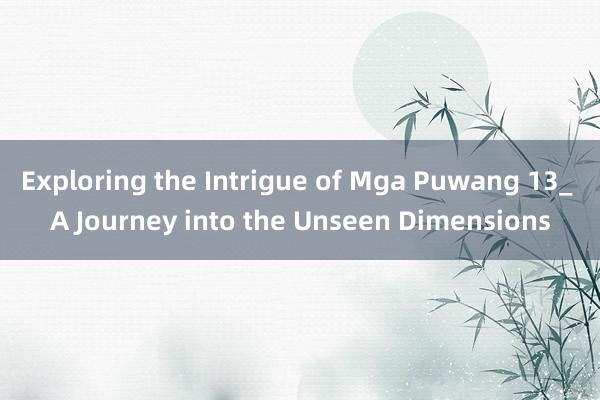Exploring the Intrigue of Mga Puwang 13_ A Journey into the Unseen Dimensions

Unveiling the Mystery of "Mga Puwang 13" - An Introduction to the Concept of Space and Time

In the world of art, literature, and philosophy, certain themes resonate deeply with the human experience, sparking curiosity and inspiring countless interpretations. One such theme is "Mga Puwang 13", which can be loosely translated as "Spaces 13" in English. At first glance, it may seem like an abstract and enigmatic phrase, but once you delve deeper, the concept of "Mga Puwang 13" reveals a rich tapestry of possibilities, both in terms of narrative exploration and symbolic significance.
The term "Mga Puwang", which translates to "spaces" in English, speaks to the vast, undefined areas of existence that often go unnoticed in the everyday hustle of life. It evokes the sensation of unexplored voids, liminal spaces where time, reality, and consciousness can become fluid, stretching our understanding of the world. By introducing the number 13 into the equation, "Mga Puwang 13" takes on an added layer of meaning, drawing upon numerology, superstition, and myth. The number 13 is often considered a symbol of mystery, with both positive and negative connotations, depending on the culture.
In Filipino culture, "13" is sometimes viewed as an ominous number, linked to superstition and fear. However, in the context of "Mga Puwang 13," it can be interpreted as a challenge to confront the unknown, to transcend conventional understanding, and to break free from societal constraints. The use of "13" thus acts as a gateway to explore deeper questions about existence, identity, and the nature of reality itself.
Breaking Down "Mga Puwang 13": What Lies Beyond?
To truly understand the essence of "Mga Puwang 13," one must first embrace the idea of space as more than just a physical concept. Space is a dynamic entity, constantly shifting and evolving, especially when combined with the idea of the number 13, which suggests an unpredictable, even supernatural quality. Think of this as a space between the dimensions, where both the familiar and the bizarre can coexist, giving birth to surreal experiences.
In terms of storytelling and narrative structures, "Mga Puwang 13" invites us to explore narratives that exist outside traditional boundaries. Whether through literature, visual arts, or multimedia experiences, the idea of unexplored spaces often leads to moments of introspection, wonder, and existential questioning. For example, science fiction literature frequently delves into "space" as a backdrop for exploring the limits of human knowledge and understanding, while contemporary art experiments with abstract representations of space to provoke thought and discussion.
Philosophical Ramifications: The Absence and Presence of Space
On a more philosophical level, "Mga Puwang 13" can be viewed as a meditation on the nature of existence itself. Philosophers have long debated the concept of nothingness or the void, trying to define what exists beyond the confines of tangible reality. If the number 13 represents a departure from the norm, then the spaces it opens up can symbolize the unknown, go88 tài xỉu the uncharted territory of thought, phim rule 34 and the vast emptiness that exists between moments of clarity.
This empty space,chich69 or "puwang," can also represent time—a crucial yet intangible aspect of life. In a world where time is ever-moving, we often find ourselves reflecting on moments lost, wondering about spaces we have yet to occupy. The void of time creates opportunities for transformation, as characters within stories, artworks, or even personal experiences grapple with the passage of time in both literal and metaphorical senses.
In Filipino literature, art, and film, the theme of space and absence is often tied to the idea of identity. The Philippines, with its rich history of colonization, migration, and cultural hybridity, is a country that has long been shaped by the tension between absence and presence. "Mga Puwang 13" could, therefore, be interpreted as an exploration of cultural identity and the spaces between tradition and modernity, belonging and alienation.
Narrative Structures: Space as a Storytelling Device
In storytelling, space becomes a critical element in shaping the narrative. Just as physical space can influence the pacing of a story, emotional space can allow for character development and thematic exploration. In a world where characters can transcend the physical confines of their environment, "Mga Puwang 13" serves as a metaphor for the moments of silence or pause that allow for personal growth and discovery.
For example, in films like "Interstellar" or "Inception," the manipulation of space and time plays a crucial role in the plot, as characters explore alternate realities or alternate versions of themselves. In these narratives, the spaces between moments are as important as the events themselves, as the boundaries between the known and the unknown blur. Similarly, "Mga Puwang 13" can be seen as a representation of this interplay between reality and illusion, prompting audiences to reconsider the spaces they occupy in their own lives.
Artistic Expression and Abstract Representation
Beyond literature and philosophy, the theme of "Mga Puwang 13" resonates strongly in abstract art. Artists have long been fascinated by the interplay between space and perception, using visual techniques to manipulate how we perceive our surroundings. The idea of "spaces 13" can be used as a framework for exploring how absence can be just as meaningful as presence. Through minimalist and conceptual art, artists can create works that focus on the voids, the empty spaces, and the silences that are often ignored in our everyday lives.
đăng ký đăng nhập slot go88The use of negative space in art often challenges viewers to reconsider the way they look at the world around them. Just as a painting can leave certain areas of the canvas untouched to create balance and harmony, "Mga Puwang 13" can symbolize the importance of embracing the unknown, the unseen, and the unexplored. Whether through sculpture, installation, or digital media, the representation of space is a powerful tool for conveying ideas that transcend language and culture.
Navigating the Universe of "Mga Puwang 13" – The Significance of the Concept in Modern Culture
As we venture deeper into the theme of "Mga Puwang 13", it becomes increasingly evident that this concept touches on more than just abstract art or philosophical musings. It is a symbol of transformation and discovery, a motif that speaks to the human condition in ways that are both universal and deeply personal.
The Role of "Mga Puwang 13" in Contemporary Culture
In contemporary culture, the theme of space continues to evolve, especially in the context of digital media and virtual worlds. The rise of virtual reality (VR) and augmented reality (AR) technologies has opened up entirely new forms of immersive experiences, creating new spaces where reality is shaped by technology and imagination. In these virtual environments, the boundaries between the real world and the digital world often become blurred, allowing users to explore alternate versions of reality, much like the undefined "puwang" in "Mga Puwang 13."
One could argue that the very essence of "Mga Puwang 13" is captured in the virtual spaces we inhabit today—spaces that are both real and imagined, spaces that allow for infinite exploration and transformation. Whether it’s in the world of gaming, digital art, or social media, the concept of space is being constantly redefined. Space is no longer just a physical or geographical entity; it is a fluid, digital realm that expands with each new technological advancement.
The Influence of "Mga Puwang 13" in Storytelling and Pop Culture
In storytelling, "Mga Puwang 13" can be seen as a blueprint for exploring the boundaries of narrative itself. Writers, filmmakers, and creators are increasingly using fragmented, non-linear storytelling techniques to mirror the complexities of the spaces and dimensions they are exploring. Films like "The Matrix," "Doctor Strange," and "The Dark Tower" all use the concept of space—both physical and metaphysical—as a central theme, drawing on the idea that reality is malleable and can be bent or distorted by forces beyond our comprehension.
In Filipino cinema, the exploration of abstract and surreal spaces has gained traction in recent years, with directors like Lav Diaz and Brillante Mendoza pushing the limits of conventional filmmaking to explore themes of time, identity, and space. These filmmakers have used slow pacing, long takes, and a focus on the environment to create immersive experiences that challenge the viewer's perception of space and reality. This mirrors the theme of "Mga Puwang 13", where the focus is not on the events themselves but on the spaces that shape those events.
Cultural and Psychological Interpretations of "Mga Puwang 13"
At a psychological level, "Mga Puwang 13" can be interpreted as a metaphor for mental and emotional spaces—the quiet places within our minds where reflection, introspection, and growth occur. The Filipino concept of "puwang" is not only a physical space but also a mental and emotional one, where the individual can process thoughts and experiences.
Psychologically, the number 13 can also be seen as a symbol of rebirth or transformation. In many cultures, the number 13 is associated with cycles of change, both positive and negative. In this sense, "Mga Puwang 13" could represent a transitional phase, a space between who we were and who we are becoming. It is in these spaces of transition that we often find the most profound growth and discovery.
Embracing the Unknown: The Power of "Mga Puwang 13"
Ultimately, "Mga Puwang 13" is a concept that challenges us to confront the unknown—to embrace the spaces we have yet to explore, both in the world around us and within ourselves. Whether in art, literature, philosophy, or personal experience, the theme of space offers a profound opportunity to reflect on the nature of existence, identity, and transformation.
As we continue to navigate an increasingly complex and interconnected world, the idea of "Mga Puwang 13" serves as a reminder that, even in the most uncertain and uncharted territories, there is potential for discovery, growth, and change. These spaces, though undefined, hold the power to shape our perceptions, challenge our assumptions, and ultimately transform our understanding of reality.
In this ever-evolving journey of exploration, the question is not "What is the space?" but rather, "What lies beyond it?"






